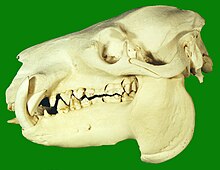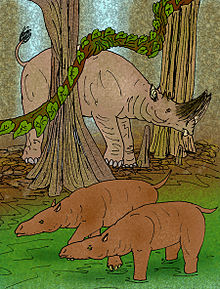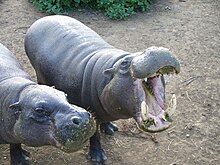Choeropsis liberiensis
The pygmy hippopotamus (Choeropsis liberiensis) is an artiodactyl mammal native to the forests and marshes of West Africa. Its specific name means "from Liberia", since it is in this country where the vast majority of specimens of the species live. It is a solitary and nocturnal animal and, along with the common hippopotamus – which is much larger – it is one of the only two living species in the hippo family.
It has numerous adaptations to the terrestrial environment, but like the common hippopotamus, it is semi-aquatic and lives in areas close to water in order to keep its skin moist and cool off from high temperatures. Activities such as mating and birth can be performed both in water and on land. Is herbivorous; It feeds on ferns, other plants and fruits found in the forests.
It is a nocturnal forest creature, which is why it is a difficult animal to study in the wild. Pygmy hippos were unknown outside of West Africa until the 19th century. They were introduced to zoos at the beginning of the 20th century, where they breed successfully and where much of the research is carried out. about these animals. The survival of specimens in captivity is more assured than in the wild: the International Union for Conservation of Nature estimates that there are fewer than 3,000 pygmy hippos in the wild. They are threatened mainly by the destruction of their habitat, since Forests are eliminated and replaced by farms and crops, by hunting - including poaching -, natural predators and wars.
Description
Pygmy hippos have the same general shape as hippos. They have a skeleton that supports the weight of a strong body, with four short legs and four toes on each foot. However, the pygmy hippopotamus is only half the height of the common hippopotamus and weighs less than a quarter of what its larger relative weighs. They measure about 75-83 centimeters high at the withers, have a length of 150-177 centimeters and weigh about 180-275 kilograms. Their longevity in captivity ranges from 30 to 55 years, although it is unlikely that they will live that long in the wild.

Their skin, greenish-black or brown, changes to a creamy gray on the lower part of the body; It is very similar to that of the common hippopotamus, with a thin epidermis above a dermis several centimeters thick. Pygmy hippos have the same unusual sweat as common hippos, turning them pink—sometimes described as “blood sweat”—although the secretion is neither sweat nor blood. This highly alkaline substance is believed to have antiseptic and sunscreen properties. Hippopotamus skin dries out quickly and cracks, which is why both species of hippopotamus spend so much time in the water.
The skeleton of the pygmy is more graceful than that of the common one, which means that, in proportion, its bones are thinner. The common spine is parallel to the ground; while that of the pygmy leans forward. This is probably an adaptation to pass more easily through the dense vegetation of the forests. In proportion, the legs and neck of the pygmy are longer and the head smaller. The pygmy's orbits and nostrils are much less pronounced, an adaptation to spending less time in deep water—where pronounced orbits and nostrils help the common hippopotamus see and breathe almost without leaving the water. The feet of pygmy hippos are less wide; but the toes are more extended and less webbed, which helps them move along the forest floor. Despite adaptations to a more terrestrial life than the common hippopotamus, pygmies remain more aquatic than any other artiodactyl.: Their ears and nostrils have strong muscular valves to help them submerge, and the physiology of their skin depends on the availability of water.
Behavior
The behavior of the pygmy hippopotamus differs from the common hippopotamus in many aspects, being more closely related to that of the tapir, although this is an effect of evolutionary convergence. While the common hippopotamus is gregarious, pygmies live either alone or in groups. small groups, typically made up of a sexual pair or a mother and her offspring, and when they meet they tend to ignore each other rather than fight. Field studies have estimated that the territories of males cover about 2 km², while those of females only 0.5 km².
They spend much of the day hiding in rivers, resting in the same place for days at a time before moving to a new location. Some use dens or burrows that form on the banks of rivers and it is not known whether they themselves contribute to excavating or how widespread their use is. Although a pygmy hippopotamus has never been observed burrowing, other artiodactyls, such as warthogs, are burrowers.
Diet
Like the common hippopotamus, the pygmy hippopotamus emerges from the water at dusk to feed. Take advantage of the paths opened by other animals to move through the dense vegetation of the forests. It marks the trail by wagging its tail while defecating to spread its manure. The pygmy hippopotamus spends about six hours a day searching for food.
Although they are herbivores, they do not feed significantly on aquatic vegetation and rarely eat grass, as this is scarce in the dense forests where they live. Most of their diet consists of ferns, broadleaf plants and fallen fruits. The wide variety of plants they have been seen to consume suggests that they are generalists, consuming any available plant. This diet is of higher quality than that of the common hippopotamus.
Playback

A study of the reproductive behavior of this animal in the wild has never been carried out. The artificial conditions in captivity suggest that the observed behavior of pygmy hippos differs from that in natural conditions. She reaches sexual maturity between three and five years of age. The earliest known birthing age was three years and three months in a female at Basel Zoo (Switzerland). The estrous cycle of a female lasts an average of 35.5 days and estrus itself lasts between 24 and 48 hours.
Pygmy hippos come together to mate, but the duration of the relationship is unknown; In zoos, they form monogamous pairs. Copulation can take place both on land and in water and each pair copulates between one and four times during an estrous period. In captivity, pygmy hippos have been conceived and given birth in all months of the year. The gestation period lasts between 190 and 210 days and usually a single calf is born, although cases of twins being born have been known.
The common hippopotamus only copulates and gives birth in water, but pygmy hippos copulate and give birth both on land and in water. They are born weighing between 4.5 and 6.2 kg, with males weighing about 250 grams more than females. The babies can swim almost as soon as they are born. During lactation, the calf does not accompany the mother when she leaves the water to look for food, but rather remains alone hidden in the water. The mother returns to the hiding place about three times a day and calls her to come and nurse with the mother lying on one side of her. Complete weaning occurs between six and eight months of age. Since 1919, 41% of pygmy hippos born in zoos have been male, so the sex ratio is at 0..7, that is, there are 0.7 males for every female.
Taxonomy and origins

The pygmy hippopotamus is a member of the family Hippopotamidae, genus Choeropsis, whose etymology means "pig-like." Until 2005, it was included in the genus Hexaprotodon —which means "six front teeth"— so Hexaprotodon liberiensis has remained a synonym of the valid name.
A "sister" of the pygmy hippopotamus could have been the little-known Malagasy pygmy hippopotamus (Choeropsis madagascariensis), which is, along with Hippopotamus lemerlei and H. laloumena, one of three species of the Hipopotamidae family from Madagascar that have become extinct in historical times—believed to have been within the last 500 years. C. madagascariensishad the same size as C. liberiensisand shared its terrestrial behavior; It inhabited the highlands of the Malagasy forest rather than the open rivers.
The taxonomy of the pygmy hippopotamus genus has changed as knowledge of this animal has developed. Samuel George Morton originally classified it as Hippopotamus minor, but later determined that it was different enough to justify its own genus and classified it as Choeropsis. In 1977, Coryndon suggested that it was closely related to Hexaprotodon, a genus that included prehistoric hippos native to Asia. This assignment was widely accepted until 2005 when Boisserie demonstrated, after a thorough analysis of the phylogeny of hippopotamids, which was not a member of Hexaprodoton but a different genus and returned the animal to the genus Choeropsis. However, the pygmy hippopotamus is the only living representative of its genus.
Subspecies
There are two subspecies of pygmy hippopotamus: C. l. liberiensisand C. l. heslopi. The first is the nominal one, that is, the one that gives its name to the species and is distributed throughout Liberia, Ivory Coast, Guinea and Sierra Leone; It is probably the only one currently alive. The second is a Nigerian subspecies, most likely extinct, that lived in the Niger Delta, especially near Port Harcourt (Nigeria), and separated by more than 1800 km and by the Togo-Dahomey corridor, a desert region that divides the regions. forests of West Africa.
There is no reliable record from the collection obtained by I. R. P. Heslop, a British colonial officer in the early 1940s, to whom the subspecific name was dedicated. Heslop, in 1945, claimed to have shot a pygmy hippopotamus in the Niger Delta region, estimating the population of that region at no more than thirty individuals, and to have collected various skulls that he sent to the Natural History Museum in London. These specimens were not taxonomically evaluated until 1969, when G. B. Corbet classified them as belonging to a distinct subspecies based on variations in cranial proportions.
Studies on this subspecies were always based on dead specimens, since it was never studied in the wild or captured alive. The sightings were made in the Nigerian states of Rivers, Imo and Bayelsa. The inhabitants of the Niger Delta were still talking about this animal in 1993, so its extinction must have occurred at the end of the 20th century, but its history in the region is poorly documented.
Evolution


The evolution of the pygmy hippopotamus is frequently studied within the context of that of the common hippopotamus. For a long time it was believed that both species had suids (pigs and related animals) or tayasuids (peccaries) as their closest relatives, but research over the last ten years has determined that hippopotamuses have their closest relatives: cetaceans (whales and dolphins). Hippos and cetaceans shared a common semi-aquatic ancestor that diverged from the other artiodactyls approximately 60 million years ago. This hypothetical ancestor probably split into two branches approximately six million years later. One branch would evolve into cetaceans., while the other did so towards the anthracotherids, a large family of quadrupedal beasts, whose first members, from the upper Eocene, would have looked like hippopotamuses of less wide proportions with a relatively small and thin head.
Hippotamids have deep roots within the anthracoterid family. The oldest known hippopotamid is from the genus Kenyapotamus, which lived in Africa between 8 and 16 million years ago. Kenyapotamus is only known from fragmentary fossils, but had a size similar to that of C. liberiensis. Hippopotamuses are believed to have evolved in Africa and, although the species once reached Asia and Europe, no hippopotamus has been discovered in the Americas. Beginning between 7.5 and 1.8 million years ago, Archaeopotamus, the probable ancestor of the genera Hippopotamus and Hexaprotodon, lived in Africa and the Middle East.
While the fossil record of hippos is still not fully understood, the lineages of the two modern genera, Hippopotamus and Choeropsis, may have diverged eight million ago of years, and the genus Saotherium may have been the ancestral form. This genus and Choeropsis are significantly more basal than Hippopotamus and Hexaprotodon, that is, they are more similar to the ancestral species of hippopotamus.
Extinct dwarf and pygmy hippopotamuses
Several species of small hippopotamids also became extinct in the Mediterranean during the late Pleistocene or early Holocene. Although sometimes known as “pygmy hippopotamuses,” these species are not believed to be closely related toC. liberiensis. Among them, the Cretan dwarf hippopotamus (Hippopotamus creutzburgi), the Sicilian hippopotamus (Hippopotamus pentlandi), the Maltese hippopotamus (Hippopotamus melitensis), the Cyprus dwarf hippopotamus (Hippopotamus minor) and the Madagascar hippopotamus (Hippopotamus lemerlei).
These species, despite being of a size comparable to that of the pygmy hippopotamus, are considered dwarf and not pygmy species. They probably descended from a normal-sized species of European hippopotamus (Hippopotamus antiquus) and achieved their reduced size through the evolutionary process of insular dwarfism.
Conservation

The most significant threat to the remaining population of the pygmy hippopotamus is the destruction of its habitat. The forests where pygmy hippos live have been subject to logging, settlement and conversion to agricultural fields for many years, with little effort to make logging sustainable. As forests decline, populations become more fragmented, leading to less genetic diversity in the population as a whole.
Due to their solitary lifestyle, they are not a target for subsistence hunting, although rural hunters hunt them opportunistically; Its meat appears to be of excellent quality, like that of a wild boar. The teeth of the pygmy hippopotamus are worthless, unlike those of the common hippopotamus. The exact effects of the civil conflicts in West Africa are unknown, but it is This is very likely to be another major threat to the species. Adult common hippos have no natural predators, but pygmies can be prey to leopards, pythons and crocodiles, although it is unknown what impact this may have on populations.
In 2007, C. liberiensis was identified as one of the first ten “target species” of the Evolutionarily Distinct and Globally Endangered Species —EDGE Species— project. The acronym "EDGE" in English means "edge, edge, limit"). This project identifies species that are evolutionarily distinct and that are highly threatened and, therefore, need greater protection to avoid their extinction. The pygmy hippopotamus was included in that list along with Sir David's zaglossus, the Hispaniola solenodon, the Bactrian camel, the baiji, the slender loris, the hirola, the golden-trunk elephant shrew, the botfly bat and the gerbil. long ears.
Basel Zoo holds the international lineage registry and coordinates all captive populations of pygmy hippos, which breed in zoos around the world. Between 1970 and 1991 the population of pygmy hippos born in captivity doubled. The survival of the species in zoos seems more likely than in the wild. Life expectancy in captivity – between 42 and 55 years – is higher than in the wild.
History and folklore

While the common hippopotamus was already known to Europeans since classical antiquity, the pygmy hippopotamus was an unknown being outside its territory until the XIX. Due to its nocturnal, elusive and nemorous habits, it was not well known among the inhabitants of its surroundings. In Liberia, the animal was traditionally called "water cow."
The first field reports on the animal mistakenly identified it as a wild boar. Various skulls of the species were sent to the American scientist Samuel George Morton when he lived in Monrovia (Liberia). The first complete specimen was collected as part of a detailed investigation of the fauna of Liberia done in the 1870s and 1880s by Dr. Johann Büttikofer. The specimens were taken to the Natural History Museum in Leiden (Netherlands).
In 1873 the first pygmy hippopotamus was brought to Europe, after being captured in Sierra Leone by a member of the British Colonial Service, but it died shortly after arriving. Starting in 1911, they were successfully introduced into European and American zoos, first arriving in Germany and then at the Bronx Zoo in New York.
In 1927, Harvey Firestone, owner of the Firestone tire company, gave a pygmy hippopotamus named Billy to American President Calvin Coolidge. Coolidge donated Billy to the Smithsonian National Zoological Park. According to the zoo, Billy is the common ancestor of most pygmy hippos in current American zoos.
Various folk tales are known about the pygmy hippopotamus. One of them says that pygmy hippos carry a shiny diamond in their mouth to help them move through the dense forests at night; by day they keep it in a hiding place, so a hunter can get the diamond if he hunts the hippopotamus during the night. The indigenous people believed that baby pygmy hippos did not suck, but rather licked secretions from the mother's skin.
Contenido relacionado
Bovidae
Swan
Puma concolor
Leopardus wiedii
Thomas Bewick